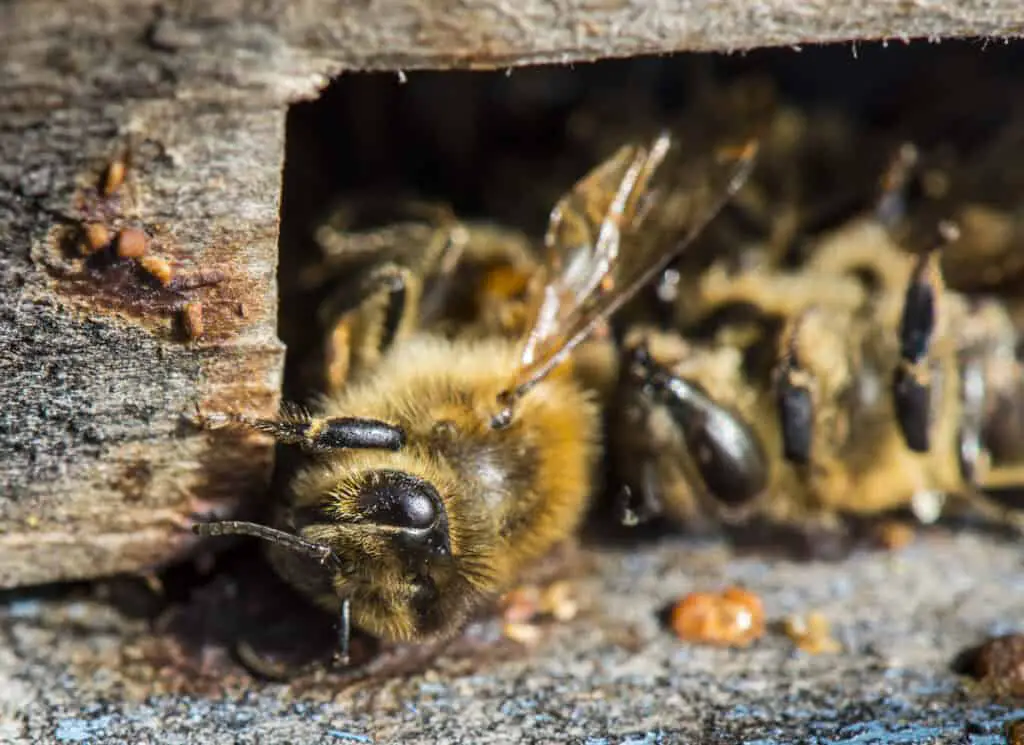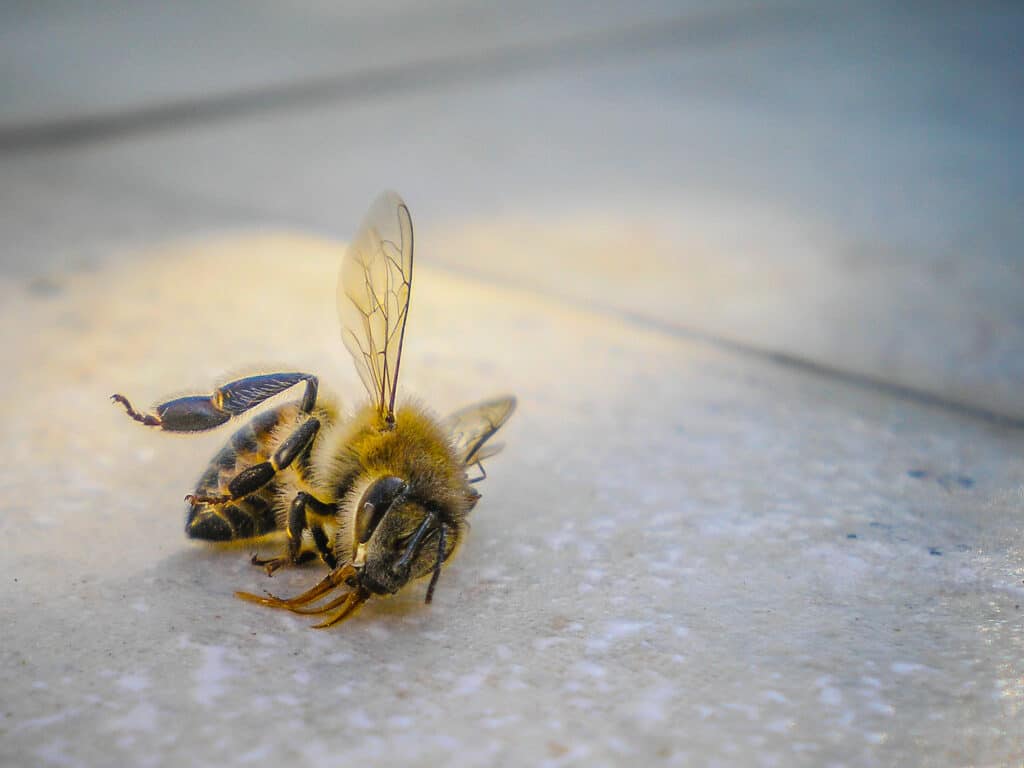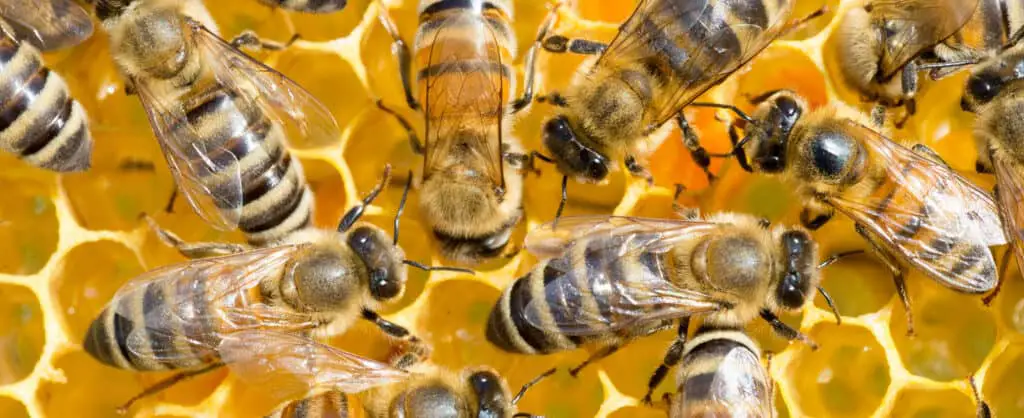There are various types of bees that we shall touch on, but the main one we shall look at is the humble honey bee that tirelessly toils away to make delicious honey. You may live in an area with plenty of bees, and perhaps they even frequent your garden, but you may have wondered how long these cute, little insects live.
Lifespans of bees range between two weeks and six years, depending on the species of the bee and their role in the colony. Generally, worker bees typically live for between two and six weeks. Drones and male bees live for around one month, and queen bees, one to two years on average.

The lifespan of bees is based on and affected by various factors such as the climate, weather patterns, availability of nectar, insecticides, and whether or not disease manages to infect the colony. There are over 20,000 known bee species, and 4,000 of these are native to the United States. We have given you the rough figures, but for a more in-depth analysis, be sure to read on.
How Long Do Honey Bees Live?

Honey bees exist in vast colonies that can be considered to be “super-organisms” in themselves, and in a single colony, you are likely to find between 50,000 and 60,000. Most of the bees within a given colony will be workers; all the different bees perform specific roles to ensure the colony’s success and its continuation.
The bee’s role and the season in which they emerge as adult bees are determining factors in their lifespans; this is especially true for the worker bees, though. The longevity of the colony relies on all bees doing their assigned roles, and if there is a weak link, it could mean their demise.
There is an array of articles, books, research papers, and studies that examine the variation in life spans of bees and the truth is that there is no specific time. But instead, windows in which all of the bees will fall, and various factors play a role, as mentioned. For example, the queens live the longest, while worker bees born in the spring and summer seasons live the shortest.
In honey bee colonies, you will find three distinguishable adult “castes”: workers, drones, and queens. Each of them is responsible for the daily running of the hive. For instance, the queen bees are tasked with producing and laying eggs, while worker bees are responsible for pollinating plants and manufacturing honey, among other things.
The time a bee lives for is based on various factors, one of which is which colony member they are.
Worker Honey Bees

The worker bees are smaller than the other colony members, and depending on the size of the hive’s population, there can be as many as 20,000 to 80,000. In their early life, they will perform duties within the safety of the hive, and once they age slightly, their tasks change to foraging for nectar from plants.
Worker bees born in the spring or summertime will live between 2-6 weeks. While if they are born in the fall (autumn), they can live as long as 20 weeks. Their initial tasks will include feeding the hungry larvae and producing the honeycomb. During this season, the colony performs at an optimal level, and there is much business in and out of the hive.
Then we get the worker bees born and raised in autumn, and there are no larvae they have to care for as the queen ceases to produce eggs during this season. If a colony is going to split, this is the time during which that is most likely to occur. The remaining workers huddle around the queen and attempt to stay warm during the winter; bees born in this period live for as long as 20 weeks.
Drone Bees (The Males)
The drones will, on average, live between 30 and 55 days; part of their job is to mate with the queen, but it is a rather sad affair for them, as once they have coupled with her, they die soon after that. This is owed to the ejaculation being so powerful that it ruptures the Endophallus. The bulb breaks off inside the queen, and the male drones perish soon after.
If, for some reason, the male is unsuccessful during the mating flight, he will be barred from the hive, and this typically occurs near the end of the summer season. The weather is cooling at this point, and without the warmth of the hive and lack of nutrients, he will die from the cold or starve to death.
Queen Honey Bees
Queen bees are sexually mature only six days after their emergence and will then begin to embark on two to three mating flights per day. After the mating flights have ended, the queen returns to the safety of the hive, and then the egg-laying begins. The queen will likely mate with 17 drones and then store the sperm required to fertilize the eggs during their lifetime.
Except for the mating flights in the initial stages of their lives, the queen bees will not venture out of the hive where they are protected. Fascinatingly a queen honey bee can lay a remarkable amount of eggs per day, usually between 1,500 and 2,000 eggs per day.
While the queen has an average lifespan of 1-2 years, they have been known to live for as long as 5 years; however, this typically only happens if she remains disease-free. Additionally, as we shall see, their potential life expectancy is far longer than that of the bumble bee queens.
If a queen bee becomes too old or loses the colony’s favor, the worker bees will begin feeding royal jelly to several larvae, with the intention of having one of them replace the queen. Once the next queen is ready to replace the old one, the worker bees will most likely smother and sting the old queen and kill her to ensure the colony’s survival.
This does not always happen, though. As mentioned earlier, sometimes colonies split; this typically occurs when the hive becomes overcrowded, and there are too many bees to accommodate. Then about half of the workers, along with the old queen, will swarm and seek a place to establish a colony. The old hive will raise a new queen, and they will continue on.
How Long Do Bumble Bees Live?
There is also no definite and exact time that a bumble bee will live for, especially since various studies have yielded differing results, especially when considering the species and their environment. Bumble bees live longer in the tropics than somewhere such as Northern Europe. Additionally, like honey bees, there are various factors, but we can give you a rough idea.
Worker Bumble Bees
There is quite a bit of disparity in terms of the length of their lives, especially regarding their roles. But on average, they live for a minimum of 2 weeks and a maximum of roughly 6 weeks. Additionally, those assigned to nest duties tend to live longer than the workers whose job is to forage.
One of the causes may be that those that venture out are far more likely to be attacked by predators and are also exposed to fluctuating weather conditions. For instance, if it begins to rain, a worker bumble bee not with the colony and out foraging will need to stop and rest, during which time they have endured the elements and are now open to attack.
Male Bumble Bees
There is little information about the lifespan of male bumble bees, and the reason for this may be that they often do not emerge from the colony along with the queens. It is understood, though, that they do not hibernate during winter, and it is theorized that they have a lifespan of a few weeks at the most.
Queen Bumble Bees
Bumble bee queens live, on average, far shorter lives than honey bees, and if they are not inflicted by disease or chemicals such as pesticides, they can expect to live for approximately one year. A part of which, unlike the males, they spend in hibernation.
How Long Do Carpenter Bees Live For?
Carpenter bees are typically more solitary than honey and bumble bees; they do not dwell in the size colonies as the other two do and instead have nests with a few other carpenter bees. The likelihood of finding many of these bees gathering together is slim to none, so what type of roles do they have, and what is their life expectancy?
Carpenter bees live for a rather extensive period, especially in comparison to worker honey bees. Carpenter bees, although predominantly solitary in their manner of living, have a life expectancy of about one full year. They do not support a hive or a colony, but all the same, they still perform the vital tasks that any worker bee would.
The females are responsible for building the nest, and once she has decided where to construct it, they will excavate a tunnel-like hole. Here she will lay her eggs, and this tunnel acts as a means to protect her and the eggs. However, the male carpenter bee has the job of guarding the female, their eggs, and their territory.
The male carpenter bees, unlike the drones of the honey bees, do not die after mating and can copulate multiple times. However, they also have relatively short lives and usually only live for a single season before they die. The eggs will then give rise to new bees in the spring; thus, the cycle continues.
The Life Cycle Of Bees
The quantity and quality of the food fed to the larvae have a massive impact on the likelihood of them becoming queen bees or worker bees. Those fed honey, pollen, and glandular secretions will develop into workers; however, if they are lucky enough to be fed the royal jelly, they will mature into queen bees.
We can pinpoint and describe key stages within the life cycle of bees. However, the length of time for each of these stages differs from species to species and what role they will ultimately take up (especially if they are honey bees that we are looking at). Additionally, the following pertains to honey bees rather than the other two we have discussed.
The Bee Egg
The worker bees build cells in which the queen bee lays her eggs; each cell is assigned a single egg, and she will lay fertilized eggs in the vast majority. These eggs will lead to the development of new worker bees or potentially the next queen. In other cells that are built larger, she will lay unfertilized eggs, and these will develop into drones. This stage of growth lasts for only three days.
The Bee Larvae
The eggs will then hatch; now, they are known as larvae and resemble a worm-like form. In the initial stages of feeding the larvae, all receive royal jelly, but then this is changed for most of them, and only the ones who are likely to be candidates for the future queen continue to receive the royal jelly.
Once this point is reached, the workers seal the cells with wax, and the larvae enter a cocoon state. The growth of the larvae is exponential in the beginning, and within a mere five days, they grow 1,500 times that of their original size. This stage lasts approximately 6 days and is shorter for the future queens and longer for the workers and drones.
The Bee Pupa
During this stage, the physical elements such as the wings, legs, and eyes develop, and the larvae begin to resemble adult bees (which will be the last and final stage in their development). Additionally, the tiny hairs you see that cover a bee’s body also start to grow.
The final stage is that the adult bee will then chew its way out of the wax cell and is fully matured. The time frame for the transition from Pupa to adult bee is most prolonged for the drones, then slightly less for the workers, and the queen takes the least amount of time. Overall, the process can take anywhere between seven and fourteen days.
Conclusion
Bees are highly fascinating creatures, and their ability to organize and run a colony is remarkable; some aspects of their functions may seem brutal and callous such as the drones dying after mating or the old queens being killed. But when the average life span of the colony members is so short, they have to do what is best for the hive and its members.
References
https://bee-health.extension.org/how-long-do-worker-honey-bees-live/
https://www.buzzaboutbees.net/how-long-do-bees-live.html
https://a-z-animals.com/blog/bee-lifespan-how-long-do-bees-live/
https://www.orkin.com/pests/stinging-pests/bees/honey-bees/honey-bee-life-span
https://www.thoughtco.com/how-long-does-a-queen-bee-live-1967993
https://www.ncbi.nlm.nih.gov/pmc/articles/PMC2527632/
https://bees.techno-science.ca/english/bees/life-in-a-hive/stages.php

